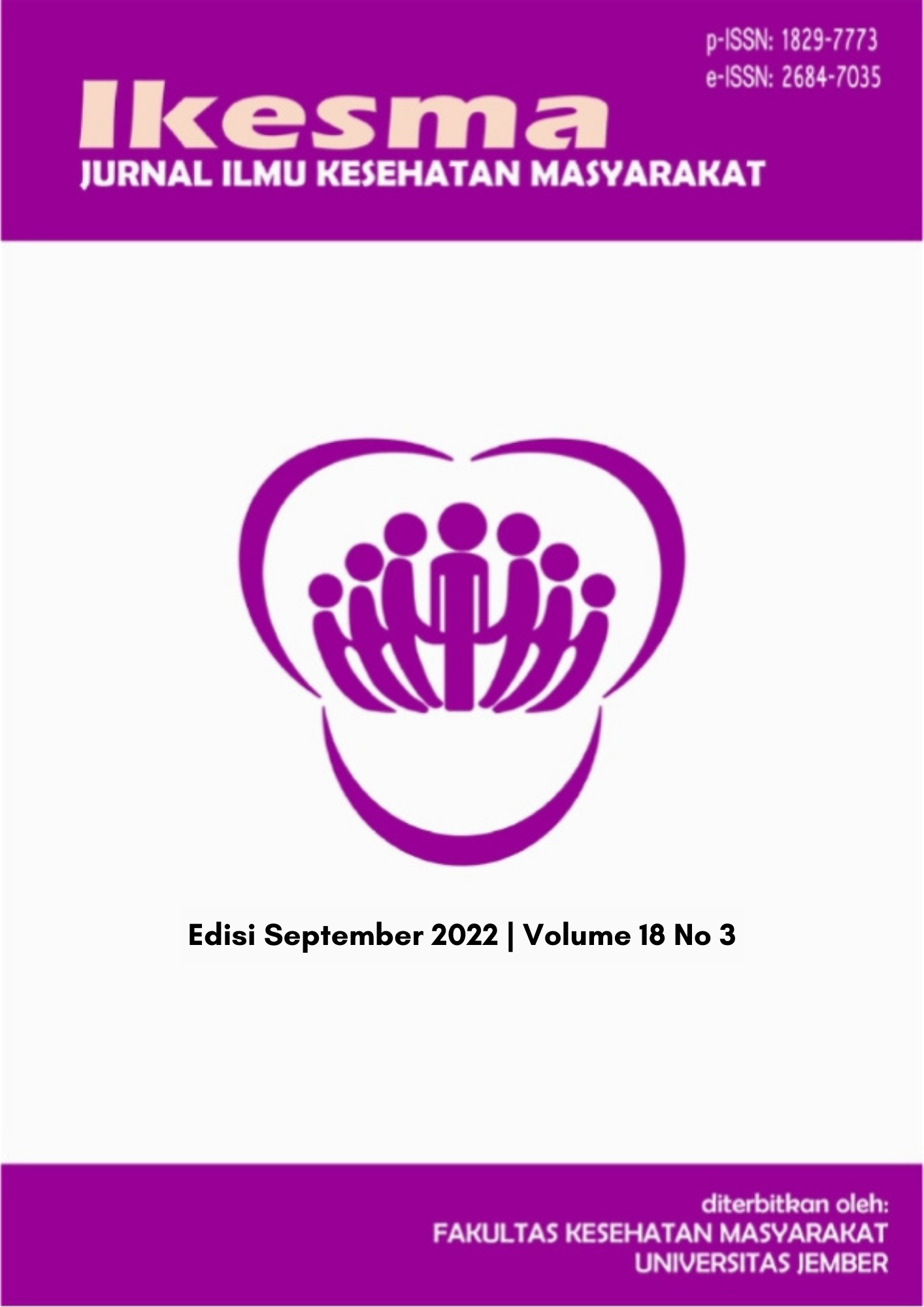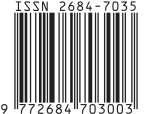FAKTOR RISIKO DAN PENCEGAHAN ANEMIA PADA WANITA USIA SUBUR DI BERBAGAI NEGARA
DOI:
https://doi.org/10.19184/ikesma.v18i3.26510Keywords:
anemia, faktor risiko, pencegahan, wanita usia suburAbstract
Anemia adalah suatu permasalahan kesehatan masyarakat secara global. Wanita usia subur adalah salah satu yang terkena dampaknya. Diketahui sekitar 528 juta (29,4%) wanita di seluruh dunia yang melahirkan mengalami anemia. Tujuan dari review ini adalah untuk menetukan prevalensi anemia pada wanita usia subur di dunia, dan mengidentifikasi faktor risiko yang paling banyak terjadi pada anemia di kelompok ini serta pencegahan yang paling efektif. Jenis penelitian ini berupa narrative literature review dengan sumber jurnal sebanyak 40 artikel berasal dari PubMed, Google Scholar, Elsevier ,BMC dengan terbitan 2015-2020 yang dikumpulkan mulai januari-juni 2021 dan setelah melalui proses screening dan kesesuaian dengan kriteria inklusi penelitian maka diperoleh 10 rujukan yang digunakan dalam penelitian ini. Hasil penelitian menunjukan prevalensi anemia tertinggi adalah di negara berkembang dan tipe anemia yang paling sering terjadi pada kelompok wanita usia subur adalah anemia yang disebabkan oleh nutrisi dan anemia pada penyakit kronis. Peningkatan risiko pada anemia berhubungan dengan beberapa faktor antara lain dengan penggunaan sumber air sebagai air minum, kehamilan, infeksi malaria pada saat kehamilan, variabel dari jumlah anggota keluarga dalam rumah tangga, pendapatan rumah tangga dalam setiap bulan, riwayat infeksi parasit pada pencernaan, durasi menstruasi, dan indeks masa tubuh sesuai dengan usia. Risiko pada anemia defisiensi zat besi berhubungan signifikan (P= 0.05) dengan menikah pada usia muda (19 tahun) dan paritas yang lebih tinggi, riwayat keluarga yang memiliki anemia defisiensi zat besi dan frekuensi konsumsi daging yang tidak rutin. Semua faktor risiko yang teridentifikasi perlu dipertimbangkan dalam menentukan strategi pencegahan dan pengendalian anemia pada wanita usia subur.
Kata Kunci: anemia, wanita usia subur, faktor risiko, pencegahan
Downloads
References
2] Al-Alimi, A.A., Bashanfer, S. and Morish, M.A. (2018a) ‘Prevalence of Iron Deficiency Anemia among University Students in Hodeida Province, Yemen’, Anemia, 2018, p. 4157876. doi:10.1155/2018/4157876.
3] Al-Alimi, A.A., Bashanfer, S. and Morish, M.A. (2018b) ‘Prevalence of Iron Deficiency Anemia among University Students in Hodeida Province, Yemen’, Anemia, 2018, p. 4157876. doi:10.1155/2018/4157876.
4] Alquaiz, A.M. et al. (2013) ‘Prevalence of anemia and associated factors in child bearing age women in riyadh, saudi arabia’, Journal of Nutrition and Metabolism, 2013, p. 636585. doi:10.1155/2013/636585.
5] Araban, M., Baharzadeh, K. and Karimy, M. (2017) ‘Nutrition modification aimed at enhancing dietary iron and folic acid intake: an application of health belief model in practice’, European Journal of Public Health, 27(2), pp. 287–292. doi:10.1093/eurpub/ckw238.
6] Aziz Ali, S. et al. (2019) ‘Factors associated with anemia among women of the reproductive age group in Thatta district: study protocol’, Reproductive Health, 16(1), p. 34. doi:10.1186/s12978-019-0688-7.
7] Bauserman, M. et al. (2019) ‘An overview of malaria in pregnancy’, Seminars in Perinatology, 43(5), pp. 282–290. doi:10.1053/j.semperi.2019.03.018.
8] Bernardi, L.A. et al. (2016) ‘The association between subjective assessment of menstrual bleeding and measures of iron deficiency anemia in premenopausal African-American women: a cross-sectional study’, BMC women’s health, 16(1), p. 50. doi:10.1186/s12905-016-0329-z.
9] Bezerra, A.G.N. et al. (2018a) ‘Anemia e fatores associados em mulheres de idade reprodutiva de um municÃpio do Nordeste brasileiro’, Revista Brasileira de Epidemiologia, 21. doi:10.1590/1980-549720180001.
10] Bezerra, A.G.N. et al. (2018b) ‘Anemia e fatores associados em mulheres de idade reprodutiva de um municÃpio do Nordeste brasileiro’, Revista Brasileira de Epidemiologia, 21(0). doi:10.1590/1980-549720180001.
11] Casey, G.J. et al. (13 Apr 17) ‘Sustained effectiveness of weekly iron-folic acid supplementation and regular deworming over 6 years in women in rural Vietnam’, PLOS Neglected Tropical Diseases, 11(4), p. e0005446. doi:10.1371/journal.pntd.0005446.
12] Gautam, S. et al. (2019) ‘Determining factors for the prevalence of anemia in women of reproductive age in Nepal: Evidence from recent national survey data’, PLOS ONE. Edited by R. Kabir, 14(6), p. e0218288. doi:10.1371/journal.pone.0218288.
13] Gautam, S. et al. (12 Jun 19) ‘Determining factors for the prevalence of anemia in women of reproductive age in Nepal: Evidence from recent national survey data’, PLOS ONE, 14(6), p. e0218288. doi:10.1371/journal.pone.0218288.
14] Hu, Y. et al. (2019) ‘Prevalence and Risk Factors for Anemia in Non-pregnant Childbearing Women from the Chinese Fifth National Health and Nutrition Survey’, International Journal of Environmental Research and Public Health, 16(7), p. 1290. doi:10.3390/ijerph16071290.
15] Irwanti, L., Sulistiyani, S. and Rohmawati, N. (2019) ‘Determinan Kejadian Anemia Gizi Besi Pada Ibu Hamil Kurang Energi Kronis Di Wilayah Kerja Puskesmas Sumberjambe Kabupaten Jember’, IKESMA, pp. 88–87. doi:10.19184/ikesma.v15i2.17553.
16] Jawed, S. et al. (2017a) ‘Frequency of nutritional anemia among female medical students of Faisalabad’, Pakistan Journal of Medical Sciences, 33(2). doi:10.12669/pjms.332.11854.
17] Jawed, S. et al. (2017b) ‘Frequency of nutritional anemia among female medical students of Faisalabad’, Pakistan Journal of Medical Sciences, 33(2), pp. 398–403. doi:10.12669/pjms.332.11854.
18] Kocaoz, S., Cirpan, R. and Degirmencioglu, A.Z. (2019) ‘The prevalence and impacts heavy menstrual bleeding on anemia, fatigue and quality of life in women of reproductive age’, Pakistan Journal of Medical Sciences, 35(2), pp. 365–370. doi:10.12669/pjms.35.2.644.
19] Kumari, R. et al. (2017) ‘Prevalence of Iron Deficiency and Iron Deficiency Anaemia in Adolescent Girls in a Tertiary Care Hospital’, Journal of clinical and diagnostic research: JCDR, 11(8), pp. BC04–BC06. doi:10.7860/JCDR/2017/26163.10325.
20] Kumari, S. et al. (2019) ‘Maternal and severe anaemia in delivering women is associated with risk of preterm and low birth weight: A cross sectional study from Jharkhand, India’, One Health (Amsterdam, Netherlands), 8, p. 100098. doi:10.1016/j.onehlt.2019.100098.
21] Methazia, J. et al. (2020) ‘An investigation of maternal anaemia among HIV infected pregnant women on antiretroviral treatment in Johannesburg, South Africa’, The Pan African Medical Journal, 37, p. 93. doi:10.11604/pamj.2020.37.93.22244.
22] Nikzad, Z. et al. (2018) ‘The relationship between iron deficiency anemia and sexual function and satisfaction among reproductive-aged Iranian women’, PLOS ONE. Edited by A. Shander, 13(12), p. e0208485. doi:10.1371/journal.pone.0208485.
23] Panyang, R., Teli, A.B. and Saikia, S.P. (2018a) ‘Prevalence of anemia among the women of childbearing age belonging to the tea garden community of Assam, India: A community-based study’, Journal of Family Medicine and Primary Care, 7(4), pp. 734–738. doi:10.4103/jfmpc.jfmpc_274_17.
24] Pels, A. and Ganzevoort, W. (2015) ‘Safety and Efficacy of Ferric Carboxymaltose in Anemic Pregnant Women: A Retrospective Case Control Study’, Obstetrics and Gynecology International, 2015, p. 728952. doi:10.1155/2015/728952.
25] Rao, S. et al. (2014) ‘Dietary diversification for prevention of anaemia among women of childbearing age from rural India’, Public Health Nutrition, 17(4), pp. 939–947. doi:10.1017/S1368980013001006.
26] Ugwu, N.I. and Uneke, C.J. (2020) ‘Iron deficiency anemia in pregnancy in Nigeria-A systematic review’, Nigerian Journal of Clinical Practice, 23(7), pp. 889–896. doi:10.4103/njcp.njcp_197_19.
27] Wiegersma, A.M. et al. (2019) ‘Association of Prenatal Maternal Anemia With Neurodevelopmental Disorders’, JAMA psychiatry, pp. 1–12. doi:10.1001/jamapsychiatry.2019.2309.
28] Zerfu, T.A., Umeta, M. and Baye, K. (2016) ‘Dietary habits, food taboos, and perceptions towards weight gain during pregnancy in Arsi, rural central Ethiopia: a qualitative cross-sectional study’, Journal of Health, Population and Nutrition, 35(1), p. 22. doi:10.1186/s41043-016-0059-8.






